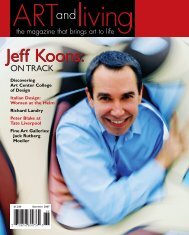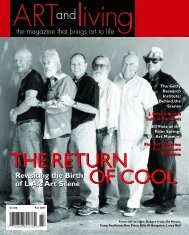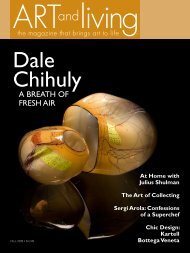Ed Ruscha Ed Ruscha Ed Ruscha - Art and Living
Ed Ruscha Ed Ruscha Ed Ruscha - Art and Living
Ed Ruscha Ed Ruscha Ed Ruscha - Art and Living
- No tags were found...
Create successful ePaper yourself
Turn your PDF publications into a flip-book with our unique Google optimized e-Paper software.
<strong>and</strong> Las Vegas’ Chinois <strong>and</strong> such accolades as the 1991 Platinum Circle Award fordesign fill the columns of Ms. Lazaroff’s resume, the titles “restaurateur” <strong>and</strong> “interiordesigner” were not always in the cards for this girl with a background in biochemistry.Growing up in the Bronx <strong>and</strong> Queens, Lazaroff’s family was of modestmeans, though her upbringing didn’t dissuade her from lofty aspirations. Like manya young lass, she had dreams of becoming a couture-designing ballerina.Eventually, her flair for the eccentric l<strong>and</strong>ed her at NYU as a theater major.Witha life in the theater came many odd jobs, one of which was at the acid-base laboratoryat Roosevelt Hospital.There, between bouts of brushing up on her Shakespeare,she developed a love for organic chemistry, which inspired her to head to a chemistryprogram at the University of California, Berkeley before heading back to NewYork <strong>and</strong> finally onward to Southern California to continue her studies in 1979.Since then, her life has not been lacking in adventure. She’s accrued two honorarydegrees (including one Ph.D.) <strong>and</strong> more than thirty business, design <strong>and</strong> humanitarianawards—all the while developing <strong>and</strong> designing restaurants throughoutAmerica, Japan <strong>and</strong> Australia.“I get obsessed,” she reveals.“The only thing that matterswhen I’m into a project is getting it accomplished as close to my vision as possible.”That fearlessness <strong>and</strong> voracious appetite for realizing her vision has led to manytriumphs, most notably to the wild success of the original Spago Hollywood, whichwas the 1994 recipient of the James Beard Foundation’s award for Restaurant of theYear.“The idea with Spago was to create a sort of playground. Spago was boisterous,free-spirited <strong>and</strong> wildly fun. It had a bold, young design spirit <strong>and</strong>, as simple as it was,there was a lot of thought involved,” she says. Barbara’s use of open ovens at Spago isoften celebrated as the creation of what is now known as the exhibition kitchen.Indeed, Lazaroff is characterized by her aptitude for out-of-the-box thinking.For instance, you might presume that an interior designer would not be all thatinterested in most matters pertaining to chemistry—organic or otherwise. Andyet, Lazaroff maintains that convergences of man <strong>and</strong> nature are present in allwalks of life. “People often think that the sciences <strong>and</strong> the arts are so unrelated,but I think that’s a misnomer—that’s a total misconception,” she says.In fact, when she designed the visceral underwater visual of Malibu’s nowclosedGranita, she drew inspiration from her days in the laboratory. “I wouldlook at the space <strong>and</strong> see the striking biomorphic <strong>and</strong> organic-looking tile <strong>and</strong>incredible glazes <strong>and</strong> all the undulating lines—it was all very reminiscent ofThe main dining room of Lazaroff <strong>and</strong> Puck’s Chinois on Main. Opened in 1983, the restaurant helped spark the “Asian fusion” trend <strong>and</strong> its interiors were lauded as Oz-like. Photo by Penny Wolin.<strong>Art</strong> <strong>and</strong> <strong>Living</strong> 109






